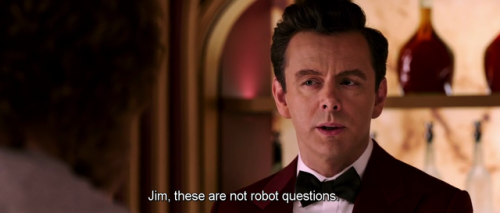
One article will state how AI is going to take over human customer service roles in the next few years. Another will defend how it’s not going to happen, after all people need people. There is however, more cause for AI to be integrated around what human agents are already doing than completely replace them.
In customer services it all depends on what the customer is enquiring about and the level of involvement that is required to fully answer their questions.
A chatbot will initially need to be taught the questions and answers the organisation wants it to respond to. This can range from simple yes/no’s, such as does the hotel room include a fridge, or will lunch be provided during the event etc. to supplying complete instructions and advice.
But what happens when “these are not robot questions”?
Unlike Jim in Passengers who was left pondering the answers as there was no one else to turn to, an organisation cannot just leave these enquiries unanswered; therefore a human agent must intervene. Whether they are transferred the chat to continue the conversation, or they are provided with contact details to follow up when they are available.
Emotions are an Important Part of the Conversation
It’s not just when the bot cannot answer a question that the involvement of a human operator is required. Depending on the nature of the enquiry, or how trustful the individual is of chatbots, they may prefer to speak with a person sooner into their enquiry.
A chatbot may not be able to able to understand fully how frustrated a consumer is, where as a representative can sympathise and start to defuse a situation. Certain scenarios may need to be escalated to a manager to authorise a resolution, it can be more detrimental for the enquiry to go from a chatbot to a customer service representative to a manager.
Having the enquirer speak directly to a human agent reduces the process and they could easily rectify any issues, or if it must be escalated it’s only one step. Therefore organisations should evaluate carefully on what areas of their customer service they integrate a chatbot into.
Some of the greatest customer service stories are the ones including humour or are heartfelt.
Tesco’s William the Worm included a customer service representative perfectly matching the customer’s tongue in cheek tone. He joined in with poems and interpretations of well-known songs after the consumer found a deceased worm in his cucumber, giving the invertebrate the best vigil the internet has ever seen.
Onto another supermarket story, and this time from Sainsbury’s where a 3 year old girl became confused on why one of their bakery products was called tiger bread. The pattern to her looked more like a giraffe therefore with help from mum and dad, she wrote a letter to their customer service department. Several years later the supermarket giant has kept with the rebrand of giraffe bread.
From one giraffe to another. When Chris Hurn of Mercantile Capital Corporation’s son left ‘Joshie’ the stuffed giraffe at a hotel he was understandable upset. To console his distressed son, Hurn contacted the Ritz and asked for them to take a photo of the giraffe on a sun lounger enjoying an extended stay. Not only did they agree the staff had a full photo-shoot with the giraffe including massages, driving a golf cart, and having his own shift with the Loss Prevention Team complete with his own ID badge. They sent Joshie home with a folder of the images of his extra time at the hotel, much to the parents amusement.
With brilliant customer service examples as these it raises the question, could chatbots get to the stage where it understands humour and goodwill fully to deliver service such as this? To achieve this, the technology would have to pass the Turing Test in order to exhibit behaviour equivalent to that of a human. It is at that point people are concerned of the development within AI as it could be indistinguishable from a human agent.
What do you think; will AI dominate customer services in the future?
